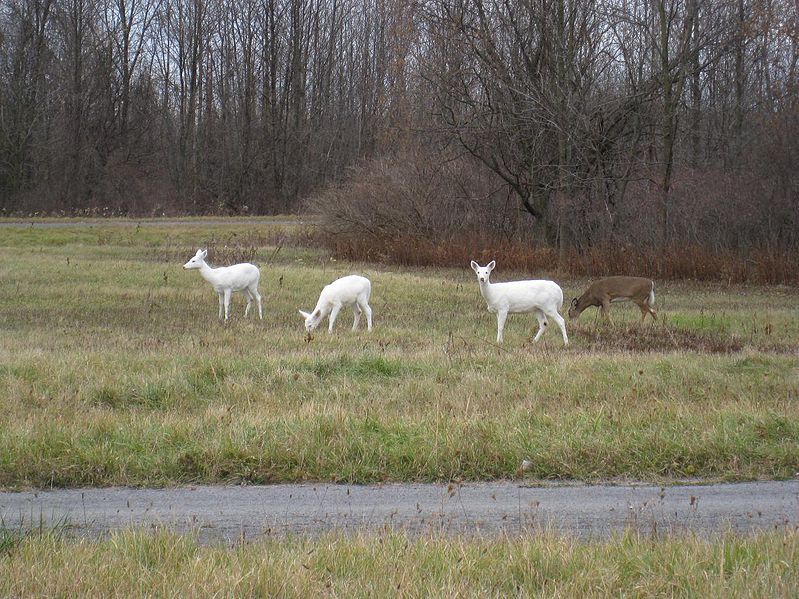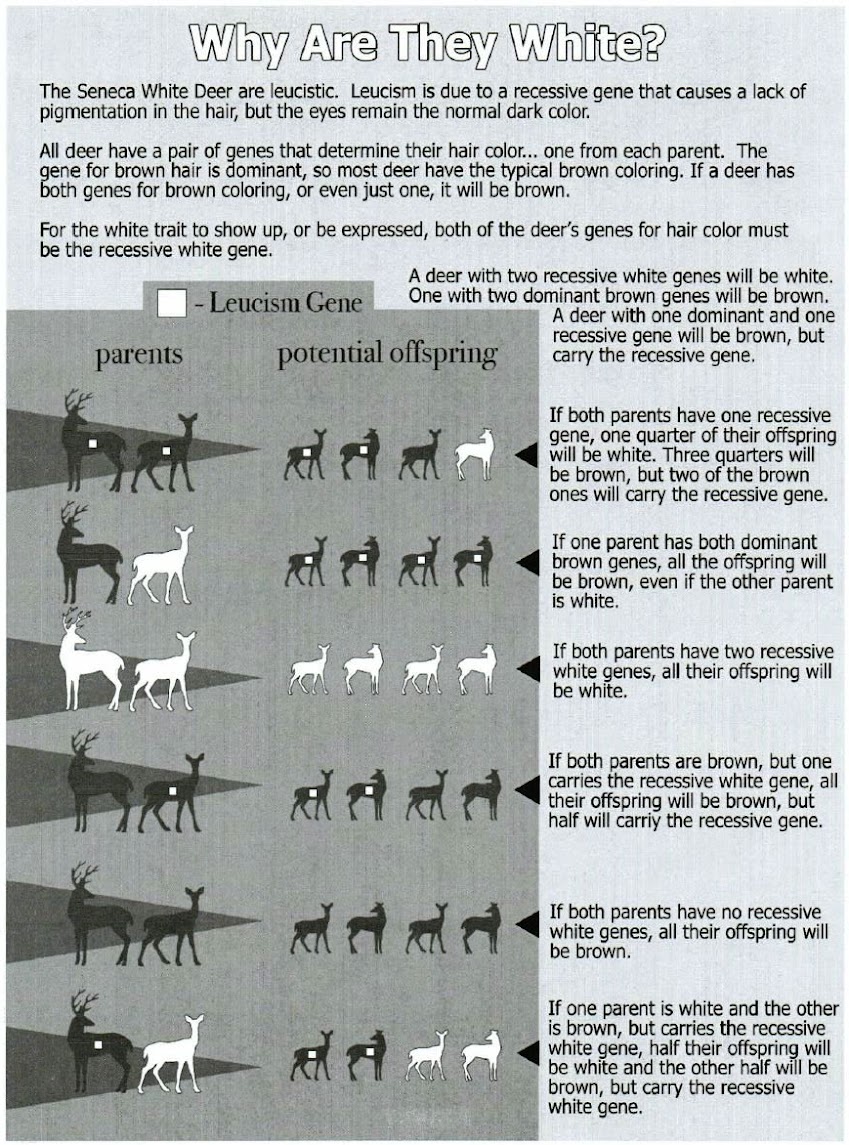 |
“Piebald deer, odocoileus
virginianus,
walking in a herd,
from U.S. Fish and Wildlife Service, Wikimedia Commons, HERE. |
The
other night I was driving with my Wife, on our way to drop off our
Granddaughter, when suddenly a six-point buck jumped from the darkness and darted
in front of the car. Now that is a pretty
common thing, especially this time of the year, and not something worth writing
about. What made it memorable though was
that this buck had both a white belly and dots and splashes of white all over
his brown sides! He was piebald! This is only the second piebald deer I have
ever seen and that is what made that drive home worth writing about.
“But
what exactly is piebald”, you might say, “and how rare is it”? Those are good questions and while I knew one
of the answers and could guess at the other, I decided to do what I always do
and do some research. And here is what I
found.
 |
“Piebald whitetailed
deer, odocoileus virginianus, from U.S. Fish and
Wildlife Service, Wikimedia Commons, HERE.
According
to Jeannine Tardiff Fleegle, of the Pennsylvania Game Commission’s Deer &
Elk Management Section, “There are only two conditions that
cause a brown deer to be white”1. These two conditions are leucism or piebaldism,
and albinism. Piebaldism
is a genetic condition which causes irregular patches of white to appear on an
animal that is otherwise normal in its color and patterning. Piebaldism is a recessive genetic condition
and is characterized by a reduction of melanin and other skin
pigmentation. In whitetail deer, odocoileus
virginianus, some piebald deer have white speckles or white splashes on
their flanks, while others are almost or are totally white; in all cases, piebald
animals will still have brown eyes, brown hooves and a brown nose. Piebald animals are not albinos. Albinism is also a recessive genetic
condition, and results only in a reduction of melanin, this causes the albino
animals to have a white coloration and pink eyes, a pink nose, and pinkish
hooves.
Additionally,
according to Fleegle, along with the color changes there are physical
conditions that can plague piebald deer; “they also typically have some
other abnormality that may include dorsal bowing of the nose (Roman nose),
short legs, curving of the spine, deviated limb joints (turned feet) and
internal organ malformations”. Fleegle
continued by saying, "those with severe defects die at birth or shortly
after”.
An excerpt from Susan Miers Smith’s article from the Reading Eagle, “Piebald
deer popping up in Berks, but what is the difference between them and albinos?”,
found HERE
Just
like albinism, piebaldism is a rare condition and sources suggest that it
affects less than 1% or 2% of the whitetail deer population.2 And that is why you might go years without
seeing a piebald deer, if you ever see one at all.
 |
White deer, leucistic not albino, on the Seneca Army
Depot Grounds, from Brian Adler, Wikimedia Commons, HERE.
So
maybe you will get lucky and see that one deer out of a hundred that has
splashes of white scattered about its sides, or maybe you will even see a
completely white animal with black eyes!
I
hope that you continue to enjoy The Woodsman’s Journal Online and look for me
on YouTube at Bandanaman Productions for other related videos, HERE. Don’t forget to follow me on both The
Woodsman’s Journal Online, HERE,
and subscribe to BandanaMan Productions on YouTube. If you have questions, as always, feel free
to leave a comment on either site. I
announce new articles on Facebook at Eric Reynolds, on Instagram at
bandanamanaproductions, and on VK at Eric Reynolds, so watch for me.
That
is all for now, and as always, until next time, Happy Trails!
Notes
1
For an excellent article on the difference between albinism and leucism or
piebald, see Susan Miers Smith’s article from the Reading Eagle, “Piebald deer popping up in Berks, but
what is the difference between them and albinos?”
2
From Susan Miers Smith’s article from the Reading
Eagle, “Piebald
deer popping up in Berks, but what is the difference between them and albinos?”
and Rick Brockway’s article from The Daily Star, “Outdoors: Piebald deer: a unusual
phenomenon”.
Sources
Adler, Brian, Wikimedia Commons;
“799px-Seneca_White_Deer_On_Army_Depot_Grounds_1”, https://commons.wikimedia.org/wiki/File:Seneca_White_Deer_On_Army_Depot_Grounds_1.JPG, accessed September 28, 2020
Brockway, Rick; “Outdoors: Piebald deer: a unusual
phenomenon”,
December 13, 2018; updated December 15, 2018; [Copyright 2020 The Daily Star], https://www.thedailystar.com/sports/local_sports/outdoors-piebald-deer-a-unusual-phenomenon/article_6d814446-4395-5a97-ba74-d5b71d4ac823.html, accessed September 28, 2020
Smith, Susan Miers; “Piebald
deer popping up in Berks, but what is the difference between them and
albinos?”, August 30, 2020, Reading Eagle, [Copyright 2020MediaNews Group, Inc.], https://www.readingeagle.com/living/piebald-deer-popping-up-in-berks-but-what-is-the-difference-between-them-and-albinos/article_6d1fc3e4-e616-11ea-9326-638f46939035.html,
accessed September 28, 2020
U.S. Fish and Wildlife
Service, Wikimedia Commons; “800px-Piebald_white_tailed_deer_grazes_walking_in_a_herd_odocoileus_virginianus”,
https://commons.wikimedia.org/wiki/File:Piebald_white_tailed_deer_grazes_walking_in_a_herd_odocoileus_virginianus.jpg, accessed September 28, 2020
U.S. Fish and Wildlife Service, Wikimedia
Commons; “800px-Piebald_whitetail_deer_animals_mammals_odocoileus_virginianus”,
https://commons.wikimedia.org/wiki/File:Piebald_whitetail_deer_animals_mammals_odocoileus_virginianus.jpg, accessed September 28, 2020


No comments:
Post a Comment